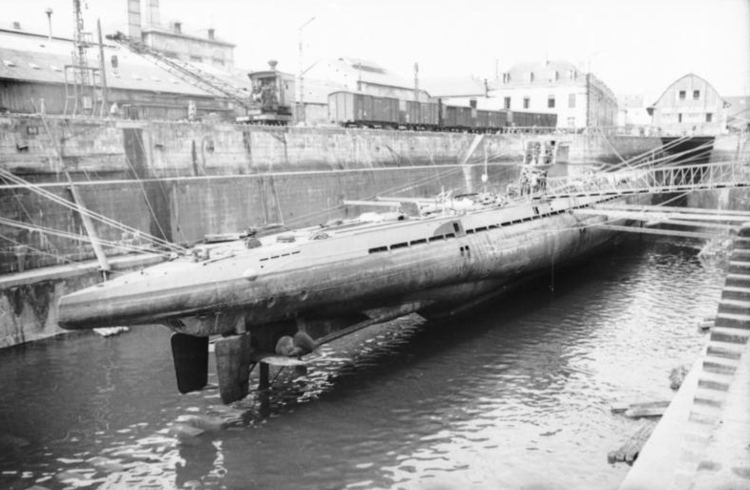Name U-42 Yard number 947 Commissioned 15 July 1939 Launched 16 February 1939 | Ordered 21 November 1936 Laid down 21 December 1937 Construction started 21 December 1937 Draft 4.7 m | |
 | ||
Fate Sunk on 13 October 1939 southwest of Ireland. 26 dead and 20 survivors Part of Kriegsmarine, 6th U-boat Flotilla | ||
German submarine U-42 was a Type IXA U-boat of Nazi Germany's Kriegsmarine that operated during World War II.
Contents
U-42 was ordered by Kriegsmarine in November 1936. Her keel was laid down in December 1937; she was launched in February 1939 and commissioned in July 1939.
U-42 had a very short career, being sunk while still on her first war patrol. During her service with Kriegsmarine, the boat conducted only one training patrol and one war patrol. Over the latter she damaged one enemy vessel of 4,803 gross register tons (GRT). Both her patrols were as part of the 6th U-boat Flotilla.
U-42 was sunk southwest of Ireland on 13 October 1939. Out of a crew of 46, 20 survived and 26 went down with the submarine.
Construction
U-42 was ordered by Kriegsmarine on 21 November 1936 (as part of Plan Z). Her keel was laid down on 21 December 1937 by DeSchiMAG AG Weser of Bremen as yard number947. She was launched on 16 February 1939 and commissioned on 15 July of that same year under the command of Kapitänleutnant Rolf Dau.
Design
As one of the eight original German Type IX submarines, later designated IXA, U-42 had a displacement of 1,032 tonnes (1,016 long tons) when at the surface and 1,153 tonnes (1,135 long tons) while submerged. The U-boat had a total length of 76.50 m (251 ft), a pressure hull length of 58.75 m (192 ft 9 in), a beam of 6.51 m (21 ft 4 in), a height of 9.40 m (30 ft 10 in), and a draught of 4.70 m (15 ft 5 in). The submarine was powered by two MAN M 9 V 40/46 supercharged four-stroke, nine-cylinder diesel engines producing a total of 4,400 metric horsepower (3,240 kW; 4,340 shp) for use while surfaced, two Siemens-Schuckert 2 GU 345/34 double-acting electric motors producing a total of 1,000 metric horsepower (740 kW; 990 shp) for use while submerged. She had two shafts and two 1.92 m (6 ft) propellers. The boat was capable of operating at depths of up to 230 metres (750 ft).
The submarine had a maximum surface speed of 18.2 knots (33.7 km/h; 20.9 mph) and a maximum submerged speed of 7.7 knots (14.3 km/h; 8.9 mph). When submerged, the boat could operate for 65–78 nautical miles (120–144 km; 75–90 mi) at 4 knots (7.4 km/h; 4.6 mph); when surfaced, she could travel 10,500 nautical miles (19,400 km; 12,100 mi) at 10 knots (19 km/h; 12 mph). U-42 was fitted with six 53.3 cm (21 in) torpedo tubes (four fitted at the bow and two at the stern), 22 torpedoes, one 10.5 cm (4.13 in) SK C/32 naval gun, 180 rounds, and a 3.7 cm (1.5 in) as well as a 2 cm (0.79 in) anti-aircraft gun. The boat had a complement of forty-eight.
Patrol
Following training exercises with the 6th Flotilla from 16 July 1939 to 1 October 1939, U-42 was moved into active service with the 6th Flotilla, ready for operations. The day after her training exercises ended, she left Wilhelmshaven on 2 October. On a 12-day journey, U-42 traveled into the North Sea and circumnavigated the British Isles. She then entered the North Atlantic in search of any Allied convoys. During this operation, one enemy ship was damaged, the 4,803-ton British steam freighter SS Stonepool, which had become separated from Convoy OB 17 while sailing from Liverpool, England to North America. This was to be the boat's first and only attack on any Allied merchant vessel. While still on her first war patrol, U-42 was sunk on 13 October 1939 by depth charges from the British destroyers HMS Imogen and HMS Ilex. This attack took place off the southwest coast of neutral Ireland. Of the 46 man crew, 26 were killed in the depth charge attack, 20 crew members survived and were made prisoners of war by the British. The youngest crew member aboard U-42 was Rudolf Nuggel who was born on 22 December 1919 and was among the 26 dead. He was 19 years old with his 20th birthday just over two months away. The captain, Rolf Dau, was the oldest known crew member of U-42. He was born on 1 April 1906 and was 33 years old at the time of the boat's sinking; he survived. U-42 was the fifth U-boat to be lost in World War II.
Fate
While still on her first war patrol, U-42 was sunk on 13 October 1939 by depth charges from the British destroyers HMS Imogen and HMS Ilex. This attack took place off the southwest coast of neutral Ireland. Of the 46 man crew, 26 were killed in the depth charge attack, 20 crew members survived and were made prisoners of war by the British. The youngest crew member aboard U-42 was Rudolf Nuggel who was born on 22 December 1919 and was among the 26 dead. He was 19 years old with his 20th birthday just over two months away. The captain, Rolf Dau, was the oldest known crew member of U-42. He was born on 1 April 1906 and was 33 years old at the time of the boat's sinking; he survived. U-42 was the fifth U-boat to be lost in World War II.
